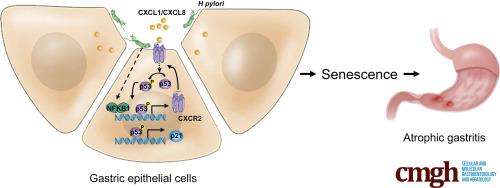Cellular and Molecular Gastroenterology and Hepatology ( IF 7.1 ) Pub Date : 2020-11-05 , DOI: 10.1016/j.jcmgh.2020.10.015 Qinbo Cai 1 , Peng Shi 1 , Yujie Yuan 2 , Jianjun Peng 2 , Xinde Ou 1 , Wen Zhou 1 , Jin Li 3 , Taiqiang Su 3 , Liangliang Lin 2 , Shirong Cai 2 , Yulong He 4 , Jianbo Xu 2

|
Background & Aims
The association between cellular senescence and Helicobacter pylori–induced atrophic gastritis is not clear. Here, we explore the role of cellular senescence in H pylori–induced atrophic gastritis and the underlying mechanism.
Methods
C57BL/6J mice were infected with H pylori for biological and mechanistic studies in vivo. Gastric precancerous lesions from patients and mouse models were collected and analyzed using senescence-associated beta-galactosidase, Sudan Black B, and immunohistochemical staining to analyze senescent cells, signaling pathways, and H pylori infection. Chromatin immunoprecipitation, luciferase reporter assays, and other techniques were used to explore the underlying mechanism in vitro.
Results
Gastric mucosa atrophy was highly associated with cellular senescence. H pylori promoted gastric epithelial cell senescence in vitro and in vivo in a manner that depended on C-X-C motif chemokine receptor 2 (CXCR2) signaling. Interestingly, H pylori infection not only up-regulated the expression of CXCR2 ligands, C-X-C motif chemokine ligands 1 and 8, but also transcriptionally up-regulated the expression of CXCR2 via the nuclear factor-κB subunit 1 directly. In addition, CXCR2 formed a positive feedback loop with p53 to continually enhance senescence. Pharmaceutical inhibition of CXCR2 in an H pylori–infected mouse model attenuated mucosal senescence and atrophy, and delayed further precancerous lesion progression.
Conclusions
Our study showed a new mechanism of H pylori–induced atrophic gastritis through CXCR2-mediated cellular senescence. Inhibition of CXCR2 signaling is suggested as a potential preventive therapy for targeting H pylori–induced atrophic gastritis. GEO data set accession numbers: GSE47797 and GSE3556.
中文翻译:

炎症相关的衰老促进幽门螺杆菌诱发的萎缩性胃炎
背景与目标
细胞衰老与幽门螺杆菌引起的萎缩性胃炎之间的关联尚不清楚。在这里,我们探讨细胞衰老在幽门螺杆菌诱导的萎缩性胃炎中的作用及其潜在机制。
方法
C57BL/6J 小鼠感染幽门螺杆菌,用于体内生物学和机制研究。收集患者和小鼠模型的胃癌前病变,并使用衰老相关 β-半乳糖苷酶、苏丹黑 B 和免疫组织化学染色进行分析,以分析衰老细胞、信号通路和幽门螺杆菌感染。使用染色质免疫沉淀、荧光素酶报告基因测定和其他技术来探索体外的潜在机制。
结果
胃粘膜萎缩与细胞衰老密切相关。幽门螺杆菌在体外和体内以依赖于 CXC 基序趋化因子受体 2 (CXCR2) 信号传导的方式促进胃上皮细胞衰老。有趣的是,幽门螺杆菌感染不仅上调CXCR2配体、CXC基序趋化因子配体1和8的表达,而且还直接通过核因子-κB亚基1转录上调CXCR2的表达。此外,CXCR2与p53形成正反馈环,持续增强衰老。在幽门螺杆菌感染的小鼠模型中,药物抑制 CXCR2 可减轻粘膜衰老和萎缩,并延缓癌前病变的进一步进展。
结论
我们的研究揭示了幽门螺杆菌通过CXCR2介导的细胞衰老诱发萎缩性胃炎的新机制。 CXCR2 信号传导的抑制被认为是针对幽门螺杆菌引起的萎缩性胃炎的潜在预防疗法。 GEO 数据集登录号:GSE47797 和 GSE3556。











































 京公网安备 11010802027423号
京公网安备 11010802027423号